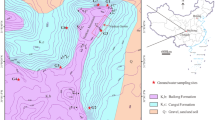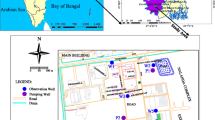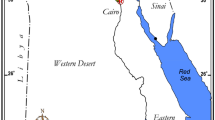Abstract
This study highlights the distribution of hydraulic conductivity (K) in the regional aquiferous Ajali Formation of SE-Nigeria on one hand and assesses the possible influences of textural and geochemical characteristics on the hydraulic conductivity on the other hand. The investigation approach involved field sampling and collection of 12 sandstone samples from different outcrop locations, followed by laboratory studies such as grain-size analysis (GSA), constant head permeameter test and geochemical analysis of major and trace elements using X-ray fluorescence method. GSA and textural studies show that the sandstones range from fine to medium sands, constituting about <75–99% sand fraction, with graphic mean grain size of 0.23–0.53 mm. Other parameters such as coefficient of uniformity (C u) range from 1.58 to 5.25 (av. 2.75), while standard deviation (sorting) values of 0.56Ø–1.24Ø imply moderately well sorted materials. In addition, the order of the estimated K values is K permeameter>K Beyer>K Hazen>K Kozeny-Carmen>K Fair-Hatch with average values of 1.4×10−3, 4.4×10−4, 3.8×10−4, 2.2×10−4 and 8.1×10−5m/s, respectively. These values fall within the range of 10−5 and 10−3m/s for fine to medium sands. However, multivariate factor analysis of the data revealed significant positive dependence of the empirically determined K values on graphic mean grain size and percentage sand content and much less dependence on sorting and total porosity. Geochemical profiles of the fresh samples are dominated by quartz with corresponding SiO2 content of 76.1–98.2% (av. 89.7%) while other major oxides are generally below 1.0wt.% in the fresh samples. However, the ferruginized samples exhibited elevated concentrations of Al2O3 (3.50–11.60wt.%) and Fe2O3 (1.80–3.60wt.%), which are clear indications of weathering/ferruginization processes with attendant trace metal release/enrichment (2.5mg/l Cu, 7.5mg/l Pb, 6.5mg/l Zn, 3.9mg/l Ni and 19.6mg/l Cr) call for concern in respect of the chemical quality of the groundwater system. The associated groundwater is generally soft, slightly acidic, and with low dissolved solids (EC=14–134μs/cm) dominated by silica; implying water from clean sandy aquifer devoid of labile and weatherable minerals. Nonetheless, most of the metals (with exception of Si, Fe and Mn) exhibited higher degree of mobility (2–12 folds), which can be attributed to reduction of Fe-/Mn-oxyhydroxides as sinks/hosts for trace metals. Consequently, infiltration-induced geochemical reactions (redox, ferruginization and leaching processes) signify potential environmental impact in terms of groundwater quality as well as borehole/aquifer management, especially under humid tropical environment of the study area.









Similar content being viewed by others
References
Adediran SA, Adegoke OS, Oshin IO (1991) The continental sediments of the Nigerian Coastal Basins. J Afr Earth Sci 12(1–2):79–84
Agagu OK, Fayose EA, Petters SW (1985) Stratigraphy and sedimentation in the Cenomanian Anambra Basin, Eastern Nigeria. Niger J Min Geol 23:25–36
Alyamani MS, Sen Z (1993) Determination of hydraulic conductivity from complete grain-size distribution curves. Ground Water 31(4)
Amajor LC (1987) Paleocurrent, petrography and provenance analyses of the Ajali Sandstone (Upper Cretaceous), southeastern Benue Trough, Nigeria. Sediment Geol 54:47–60
Angeroth CE (2002) Characterization of hydraulic conductivity of the alluvium and basin fill, Pinal Creek Basin near Globe, Arizona. USGS Water-Resources Investigations Report 02–4205, 15 pp, Tucson
Appelo C, Postma D (2005) Geochemistry, groundwater and pollution. Balkema, Amsterdam
Benkhelil J (1986) Structure and geodynamics evolution of the intracontinental Benue-Trough (Nigeria). PhD Thesis, Univ. Nice, 202 p, Pub. Elf (Nig.) Ltd
Beyer W (1964) Zur Bestimmung der Wasserdurchlaessigkeit von Kiesen und Sanden aus der Kornverteilungskurve. Wasserwirtschaft, Wassertechnik 14:165–168
Bouwer H, Rice RC (1976) A slug test for determining hydraulic conductivity of unconfined aquifers with completely or partially penetrating wells. Water Resour Res 12(3):423–428
Bruand A (2002) Concentration and mobility of lithogenic trace metals in soils: Significance of anthropogenic lateral redistributions. CR Geosci 334:581–582
Budhu M (2000) Soil mechanics and foundations, Wiley, London
Burke KC, Dessauvagie TFJ, Whiteman AJ (1972) Geological history of the Benue valley and adjacent areas. In: Dessauvagie TFJ, Whiteman AJ (eds) African geology. University of Ibadan Press, Nigeria, pp 187–218
Butler JJ Jr (1997) The design, performance, and analysis of slug tests. Lewis Publishers, Boca Raton, 272 p
Butler JJ Jr., Garnett EJ (2000) Simple procedures for analysis of slug tests in formations of high hydraulic conductivity using spreadsheet and scientific graphics software: Kansas Geological Survey Open-File Report 2000–40, 20 p
Butt CRM, Smith RE (1992) Characteristics of the weathering profile. In: Butt CRM, Zeegers H (eds) Regolith exploration geochemistry in Tropical and Sub-tropical Terrains. Elsevier, Amsterdam, pp 299–304
Carmen PC (1939) Permeability of saturated sands, soils and clays. J Agric Sci 29:263–273
Cratchley CR, Jones JP (1965) An interpretation of the geology and gravity anomalies of the Benue Valley, Nigeria. Overseas Geol Surv Geophys Pap 1:1–26
Darcy H (1856) Les Fontaines Publiques de la Ville de Dijon, Dalmont, Paris
Egboka BCE, Uma KO (1986) Comparative analysis of transmissivity and hydraulic conductivity values from the Ajali aquifer system of Nigeria. J Hydrol 82(1–2):185–196
Fair GM, Hatch LP (1933) Fundamental factors governing the streamline flow of water through sand. J Am Water Works Assoc 25:1551–1565
Freeze RA, Cherry JA (1979) Groundwater. Prentice Hall, Englewood Cliffs, NJ, 604 p
Folks RL, Ward WC (1957) Brazo river bar: a study of the significance of grain size parameters. J Sediment Geol 27:3–26
Glynn PD, Plummer LN (2005) Geochemistry and the understanding of ground-water systems. Hydrogeol J 13:263–287
Harnois L (1988) The CIW index: a new chemical index of weathering. Sediment Geol 55:319–322
Hazen A (1892) Some physical properties of sands and gravels. Mass. State Board of Health, 24th Annual Report, pp 539–556
Hazen A (1930) Water supply, American civil engineers handbook. Wiley, New York, pp 1444–1518
Hoque M, Ezepue MC (1977) Petrology and palaeogeography of the Ajali Sandstone. J Min Geol 14(1):6–22
Hudson RO, Golding DL (1997) Controls on groundwater chemistry in subalpine catchments in the southem interior of British Columbia. J Hydrol 20l:1–20
King LC (1950) Outline and disruption of Gondwanaland. Geol Mag 87:353–359
Krumbein WC, Monk GD (1942) Permeability as a function of the size parameters of unconsolidated sand. Am Inst Mining Eng, Littleton, CO, Tech Pub, pp 153–163
Ladipo KO (1986) Tidal shelf depositional model for the Ajali Sandstone, Anambra Basin, Southern Nigeria. J Afr Earth Sci 5(2):177–185
Ladipo KO (1988) Paleogeography, sedimentation and tectonics of the upper cretaceous Anambra basin, southeastern Nigeria. J Afr Earth Sci 7(5–6):865–871
Lee SS (1998) Estimation of hydraulic conductivity from grain size, grain shape, and porosity. http://www.vadose.net/hycunduc.html#top
Llyod JW, Heathcote JA (1985) Natural inorganic hydrochemistry in relation to groundwater: an introduction. Clarendon Press, Oxford; 296 p
Massart DL, Kaufman L (1983) The interpretation of analytical chemical data by the use of cluster analysis. Wiley, NY
MacDonald A, Davies J, Calow R, Chilton J (2005) Developing groundwater: a guide for rural water supply. ITDG Publishing, UK, 358 p
Minarik L, Zigova A, Bendl J, Skrivan P, Stastny M (1998) The behaviour of rare-earth elements and Y during the rock weathering and soil formation in the Ricany granite massif, central Bohemia. Sci Total Environ 215:101–111
Murat RC (1972) Stratigraphy and palaeogeography of the Cretaceous and Lower Tertiary in southern Nigeria. In: Dessauvagie TFJ, Whiteman AJ (eds) African geology, pp 251–266
Nesbitt HW, Young GM (1982) Early Proterozoic climates and plate motions inferred from major element chemistry of lutites. Nature 299:715–717
Nesbitt HW, Young GM (1989) Formation and diagenesis of weathering profiles. J Geol 97:129–147
Nesbitt HW, Young GM, McLennan SM, Keays RR (1996) Effect of chemical weathering and sorting on the petrogenesis of siliciclastic sediments, with implications for provenance studies. J Geol 104:525–542
Nwachukwu SO (1972) The tectonic evolution of the southern portion of the Benue-trough. Geol Mag 109:411–419
Nwajide CS (1979) A lithostratigraphic analysis of the Nanka Sands, southeastern Nigeria. J Min Geol 16:103–109
Nwajide CS, Hoque M (1979) Gullying processes in southeastern Nigeria. Niger Field XLIV:64–74
Obaje NG, Ulu OK, Petters SW (1999) Biostratigraphic and geochemical controls of hydrocarbon prospects in the Benue Trough and the Anambra Basin, Nigeria. NAPE Bull 14(1):18–54
Okagbue CO (1988) Hydrology and chemical characteristics of surface and groundwater resources of the Okigwe Area and Environs, Imo State, Nigeria. In: Ofoegbu CO (ed) Groundwater and mineral resources of Nigeria. Friedr Vieweg & Sohn, Braunschweig/Weisbaden, pp 3–15
Quantin C, Becquer T, Berthelin J (2002) Mn-oxide: a major source of easily mobilisable Co and Ni under reducing conditions in New Caledonia Ferrasols. CR Geosci 334:273–278
Reyment RA (1965) Aspects of geology of Nigeria, Univ Ibadan, Press, 145 p
Roquin C, Freyssinet Ph, Zeegers H, Tardy Y (1990) Elements distribution patterns in laterites of southern Mali: consequences for geochemical prospecting and mineral exploration. Appl Geochem 5:303–315
Sharma A, Rajamani V (2000) Weathering of gneissic rocks in the upper reaches of Cauvery River, south India: implications to neotectonics of the region. Chem Geol 166:203–223
Shephered RG (1989) Correlations with permeability and grain size. Ground Water 27(5)
Simeonov V, Stratis JA, Samara C, Zachariadis G, Vousta D, Anthemidis A, Sofoniou M, Kouimtzis Th (2003) Assessment of the surface water quality in Northern Greece. Water Res 37:4119–4124
Smedley PL, Kinniburgh DG (2002) A review of source, behaviour and distribution of arsenic in natural waters. Appl Geochem 17:517–568
SON (2007) Nigerian Standards for Drinking Water Quality. Standard Organization of Nigeria (SON) Publ. NIS-554; 30 p
Taylor GR, Eggleton RA (2001) Regolith geology and geomorphology. Wiley, NY, 375 p
Tijani MN (1996) Iron in shallow ground water in Moro Area, Kwara State, Nigeria. Water Int 21(4):206–212
Tijani MN, Okunlola OA, Abimbola AF (2006) Lithogenic concentrations of trace metals in soils and saprolites over crystalline basement rocks: a case study from SW Nigeria. J Afr Earth Sci 46:427–438
Tóth J (1999) Groundwater as a geologic agent: an overview of the causes, processes, and manifestations. Hydrogeol J 7:1–14
Uma KO, Onuoha KM (1988) Groundwater fluxes and gully development in S.E. Nigeria. In: Ofoegbu CO (ed) Groundwater and mineral resources of Nigeria. Friedr. Vieweg & Sohn, Braunschweig/Weisbaden, pp 39–59
Uma KO, Egboka BCE, Onuoha KM (1989) New statistical grain-size method for evaluating the hydraulic conductivity of sandy aquifers. J Hydrol 108:343–366
Vrbka P, Ojo JO, Gebhardt H (1999). Hydraulic characteristics of the Maastrichtian sedimentary rocks of the southeastern Bida Basin, central Nigeria. J Afr Earth Sci 29(4):659–667
WHO (1993) Guidelines for Drinking Water Quality–2. WHO, Geneva
Acknowledgments
The authors acknowledge with thanks the donation of the laboratory permeameter set-up used in this study by Prof. K. Jinno (Institute of Environmental Systems, Kyushu University, Fukuoka, Japan) while the assistance of Mr. K. Watanabe and Prof. Kitagawa (Department of Earth and Planetary Science Systems, Hiroshima University, Japan) in respect of the XRF analyses is also appreciated. The assistance of Toyin Alli and Ben Obinwa in the field sampling and laboratory permeameter tests is gratefully commendable, while the useful suggestions of Prof. E.P. Loehnert (Muenster, FRG) and the comments of the anonymous reviewers are also thankfully appreciated. Finally, the benefit of JSPS fellowship support to the first author, during which this manuscript was prepared is gratefully acknowledged.
Author information
Authors and Affiliations
Corresponding author
Rights and permissions
About this article
Cite this article
Tijani, M.N., Nton, M.E. Hydraulic, textural and geochemical characteristics of the Ajali Formation, Anambra Basin, Nigeria: implication for groundwater quality. Environ Geol 56, 935–951 (2009). https://doi.org/10.1007/s00254-008-1196-1
Received:
Accepted:
Published:
Issue Date:
DOI: https://doi.org/10.1007/s00254-008-1196-1




